High-yielding hybrid tomato "Alhambra", pleasing with large juicy fruits and resistant to diseases
We present to your attention an English hybrid - the Alhambra tomato. Despite the fact that the crop was bred in different climatic conditions, it has taken root well in Russian garden beds and has won a considerable number of fans. And this is not surprising: ripe vegetables are so tasty and different from other varieties that they cannot be confused with anything else.
These tomatoes are rich in lycopene and vitamins A and C, which helps strengthen the immune system during the summer. And lycopene is a source of good mood, which, of course, is important for maintaining health at any age.
Description of culture
The country of origin of the f1 hybrid is Great Britain. The seeds of the hybrid are distributed by the British company Johnsons. This is one of the oldest trading and manufacturing companies in Great Britain, created by two English amateur gardeners in 1820.
Johnson's Alhambra tomato seed material can be purchased from the Aelita agricultural company, which in 2019 became the official distributor of the British company.
Distinctive features
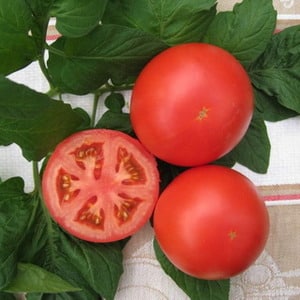 View indeterminate, tall. The inflorescences are simple, the first one is planted above the 9-10th leaf, the subsequent ones - every 2 leaves. The foliage is medium, the leaves are bright green. Each fruiting cluster produces 4-6 fruits.
View indeterminate, tall. The inflorescences are simple, the first one is planted above the 9-10th leaf, the subsequent ones - every 2 leaves. The foliage is medium, the leaves are bright green. Each fruiting cluster produces 4-6 fruits.
The ripening period is average; 110-115 days pass from the emergence of seedlings to full ripening.
The productivity is high, there is the possibility of obtaining a double harvest.At the first collection, they collect from 1 square. m up to 15 kg of vegetables, in the second rotation the average figure reaches 17 kg per 1 sq. m.
The hybrid is characterized by increased resistance to diseases: cladosporiosis, blossom end rot, tobacco mosaic virus, fusarium.
Recommended for cultivation in open ground and greenhouse conditions.
Fruit characteristics
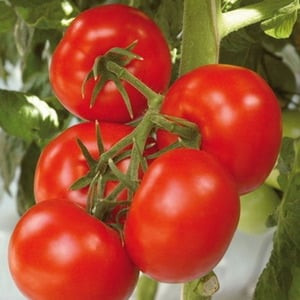 The average weight of one fruit is 160-200 g. The shape is round, slightly flattened at the top and bottom. The color is bright red, the taste is pleasant, sweet, the flesh is juicy, the peel is dense and does not crack. There are 4-5 seed chambers.
The average weight of one fruit is 160-200 g. The shape is round, slightly flattened at the top and bottom. The color is bright red, the taste is pleasant, sweet, the flesh is juicy, the peel is dense and does not crack. There are 4-5 seed chambers.
Ripe tomatoes retain an attractive presentation for a long time and can withstand long-term transportation, so they are often grown for commercial purposes. Ripe vegetables are readily purchased by trade organizations on a large scale.
The photo shows Alhambra tomatoes.
How to grow seedlings
Seeds are bought in specialized stores. Before sowing into the ground, a number of preventive measures are carried out.
Seed preparation
The seed material is laid out on the table and carefully inspected for visible defects. Viable grains should be light in color, without damage or distortion. They are then placed in a saline solution (1 teaspoon of salt in a glass of water) for 10 minutes. Those seeds that float to the surface are not suitable for sowing, since they are hollow inside.
Next, disinfection is carried out in a weak solution. potassium permanganate within 20 minutes. The grains are placed in a gauze bag and lowered into a glass with a solution. After disinfection, they are washed with running water and dried.
Reference. Disinfection of seed material will further protect plants from viral and fungal diseases.
To improve germination, seeds are soaked in a growth stimulator for 12 hours. The swollen grains are ready for sowing.
Container and soil
The soil is prepared from turf soil and peat mixed in equal quantities. To make it easier, add washed river sand and a little mineral fertilizer to the resulting mixture. The soil is disinfected to destroy pathogenic flora. To do this, it is poured with a hot solution of dark potassium permanganate or steamed in the oven for 15 minutes at a temperature of 50°C. The cooled soil is laid out in planting containers.
Plant in a common wooden box or individual containers - peat or plastic cups. The process of growing in peat containers simplifies the care of seedlings in the future. In addition, during development, it receives additional nutrients contained in the walls of peat containers.
Sowing
The grains are sown to a depth of 1.5 cm with a distance of 2 cm from each other. Sprinkle the soil on top, level it and lightly moisten it with warm, settled water from a spray bottle. Then the containers are covered with film and left in a warm room at a temperature of 20°C. Every day the film is removed for ventilation and the top layer of soil is moistened as it dries out.
The first shoots begin to appear within a week.
Seedling care
When the first shoots appear, the film is removed and the containers are moved to a well-lit place, on the windowsill. Water as needed with warm, settled water from a shallow watering can, along the edge of the nursery, without flooding the sprouts, but slightly moistening them.
Attention! Overmoistening the soil will negatively affect young roots and they will begin to rot.
Seedlings that have grown to 8-10 cm are planted, planted in separate containers twice the size of those in which the seeds were sown. The picking procedure involves removing the main root by one third.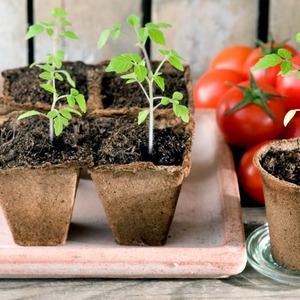
After picking, the seedlings are kept at a temperature of 16°C. This will prepare it for further hardening before transplanting into the ground.
Seedlings begin to harden off 2-3 weeks before transplanting. They are taken outside in the daytime for 40 minutes, gradually increasing this interval to 12 hours. At the same time, the night temperature is reduced to 12°C. The hardening procedure helps seedlings quickly adapt to outdoor conditions.
How to grow tomatoes
After two months, the seedlings are ready to be transplanted into the ground. Seedlings are transplanted into closed ground at the beginning of April, into open beds at the end of April-beginning of May.
Landing
Beds for tomatoes are chosen in a sunny, draft-free place. In protected soil, seedlings are planted in large pots or boxes. In open beds they are transplanted into shallow holes, having previously placed a little wood ash and mineral fertilizers on the bottom of each. After planting, the soil is slightly moistened and left to get used to the new conditions for 1 week.
Planting pattern: 45 cm – distance between seedlings, 55 cm – between rows. For 1 sq. m place no more than three plants.
Further care
Water the plants regularly, no more than 2 times a week. On hot and dry days, the amount of watering is increased depending on the condition of the soil. Water with warm water at the root in the morning. The culture responds well to drip irrigation - through a plastic bottle without a bottom installed in the root system.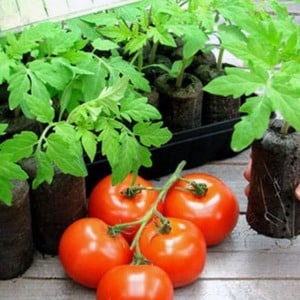
After each watering, the soil is loosened and all weeds and roots are removed.On dry days the beds mulch peat or straw for longer moisture retention.
The hybrid is fed with a full complex of mineral fertilizers 2 weeks after transplanting into the ground. Subsequent feeding carried out once every 2-3 weeks with the same fertilizer or organic matter.
Mullein infusion is used as organic matter in a ratio of 1:10. During fruiting, potassium salts are added to mineral fertilizers for faster fruiting.
Features of cultivation and possible difficulties
When transplanting, vertical supports are installed next to each bush for subsequent gartering of tall plants. Not only the stems are fixed, but also the fruit-bearing branches, since they cannot withstand the weight of ripe fruits. The support is metal rods or wooden stakes. If some fruitful branches cannot be attached to the support, additional supports are installed.
The formation of plants consists of normalizing the number of fruits on fruit-bearing branches. On the lowest ones, 4 ovaries are left, and on the subsequent ones - 5 ovaries. Thanks to this technique, the fruits grow larger.
When 4-6 inflorescences appear on the bushes, they begin to regularly remove the stepsons and pinch the tops of the plants.
Diseases and pests
The hybrid genes contain high resistance to dangerous diseases of the nightshade family.. It is practically not susceptible to tobacco mosaic virus, cladosporiosis, and fusarium. Also, the hybrid is not afraid of blossom end rot. But in the summer, plants can be attacked by insect pests. And, as you know, it is much easier to take preventive measures to eliminate them than to get rid of parasites.
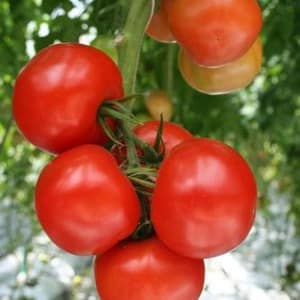 Strong-smelling bushes planted next to the tomatoes, such as mustard, calendula, marigolds or onions, will get rid of whiteflies and Colorado potato beetles. Spraying with decoctions of onion peels and garlic also helps against many insects.
Strong-smelling bushes planted next to the tomatoes, such as mustard, calendula, marigolds or onions, will get rid of whiteflies and Colorado potato beetles. Spraying with decoctions of onion peels and garlic also helps against many insects.
Treating plant stems with soapy water will get rid of aphids and slugs.. It is prepared by dissolving 1 piece of laundry soap in 1 bucket of water. Slugs also follow the smell of beer well, so when slugs accumulate in a garden plot, gardeners set up beer traps.
Medvedka does not like strong odors. For preventive purposes, crushed heads of garlic or fish heads are dug into the beds, which, when rotting, repel many pests with a pungent odor.
The nuances of breeding a hybrid in various conditions
The culture is recommended for cultivation in open and protected ground. It is also successfully grown on the balcony, at home, by pinching the top of the plants in advance, thereby preventing further growth.
The lower leaves must be removed, since if they come into contact with wet beds, they can cause the development of fungal infections. When growing a hybrid in a greenhouse, the room is ventilated to reduce humidity.
Treatment of greenhouse soil using sulfur smoke bombs begins after harvesting. The gases penetrate deep into the soil and destroy fungal spores and many pests. The walls of the greenhouse are sprayed with copper sulfate. The top layer of soil at the next planting is replaced and disinfected with a weak solution of potassium permanganate.
In open ground, the soil for tomatoes is prepared in the fall. They dig it up and apply mineral fertilizers.
Harvesting and application
In open ground, the harvest begins in August. Greenhouse plants bear fruit from June to mid-October. Vegetables ripen almost simultaneously, which makes harvesting much easier.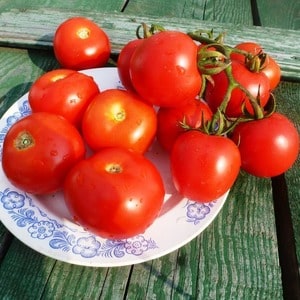
The purpose in cooking is universal. Tomatoes are great for fresh salads, hot and vegetable dishes, and do not lose their taste when baked with meat. They are used to make pizza, sandwiches and a variety of snacks.
Tomatoes are suitable for whole-fruit canning, pickles, and marinades. They perfectly preserve taste in tomato products: juices, pastes, ketchups, lecho, adjika.
Ripe vegetables are subject to long-term storage and do not lose their presentation within 1 month. Tomatoes can withstand long-term transportation, so the variety is bred for sale.
Advantages and disadvantages
The positive aspects of the hybrid include:
- adaptation to any climatic conditions;
- immunity to many dangerous diseases;
- high productivity;
- possibility of obtaining a double harvest;
- excellent taste of fruits;
- amicable maturation;
- preservation of presentation for a long time;
- versatility in cooking;
- long-term storage;
- possibility of long-term transportation.
The negative aspects include:
- Garter required;
- regular stepsoning is required;
- pinching the crown to limit growth;
- regular feeding.
Farmer reviews
Reviews about the hybrid are only positive. Those who have planted the Alhambra tomato definitely advise everyone to try it.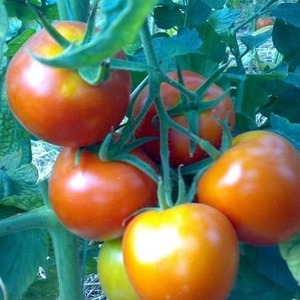
Anna, Svetly Yar: “Alhambra is a very good variety, productive, didn’t get sick, and the tomatoes are tasty, I didn’t notice any sourness. I fed it twice a month, watered it infrequently, and fed it sparingly. Made some great twists and great juice for the winter. Plant everything, you won’t regret it.”
Yaroslav, Tver: “I planted a hybrid for the first time this year. I really liked it. There was little effort expended, but it bore fruit perfectly. The only thing is that in the greenhouse I often pinched the tops to limit growth and grew the crop in large boxes. But there is nothing complicated about it. I was pleased with the result."
Conclusion
A high-yielding hybrid, immune to many diseases, has taken root in garden beds in Russian regions. For most farmers, this variety is a real money maker.
Due to their attractive appearance and delicious taste, ripe vegetables are readily purchased by trade organizations. Growing Alhambra is not difficult, but since it is a hybrid, you will not be able to independently prepare seeds from the resulting harvest.